Destroyer Neustrashimy (1952)
Neustrashimy (“Dauntless”) was an attempt by the admiralty to replace the large-scale Skoriy class destroyers in the early 1950s by a larger, more capable ship, comparable to the new generation of 1950s USN “feet escorts”, and with an equally large producton scale. This prototype however was considered too large and costly for series production and shelved by Kruchtchev after the death of Stalin, while a modified, more modern design, the Kotlin class was chosen instead. Soviet Designation was Project 41 and she was reported by NATO as the “Tallinn class”. Built by Zhdanov Shipyard (Leningrad) between 1950 and January 1952 she was only commissioned on 31 January 1955, after making extensive trials and receiving fixes in between. She served in the Baltic Fleet, decommissioned in February 1974.
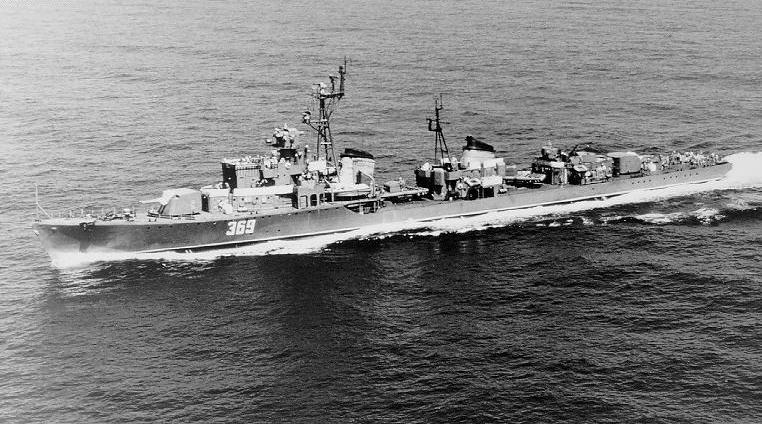
Skoryy class destroyers, the current mass-built postwar serie (just started at the time)
Genesis of a new destroyer (1947-50)

Project 48 and 48K, better known as the “Kiev class”
The new first true Soviet post-war destroyer project was not proyekt 30-bis (Skoryy) class (largely a souped-up WW2 Ognevoi), but in reality project 41, the tactical and technical assignment for its development being approved on June 14, 1947, by TTZ. This was essentially a successor of both the Ognevoi and Skoryy class, mass-produced new generation destroyer designed for a cold war context. It was larger, faster, had a greater range, and was better armed than previous ones in many ways. This was the greenlight for development. Project 41 was the result of a fusion between project 48 development, never completed, and Project 40 destroyers. Project 48 was the prewar Kiev class, successors of the Tashkent flotilla leader. They were never completed but in size and power, were something as an upper limit for Soviet destroyers at the time.

Project 40 destroyers (1943) which inaugurated the new turret type in development at the time, adopted by postwar destroyers.
Project 40 was a successor design to the late 1930s Ognevoi class: It had three twin 130 mm turrets, two quintuple torpedo tubes over a displacement of 2,890 tons standard and 4,090 tons fully loaded, 135 m x 13.5 m x 3.87 m, 2 GTZA geared steam turbines and 4-6 water-tube boilers on 2 propellers rated for 72,000, up to 81,200 shp and a top speed between 36 and 40 knots. Project 40N saw a lot of discussions about armament, three twin 130mm/57 SM-2-1 DP and six twin 45mm/78 SM-16 twin AA or in the modified version four quadruple 45mm/78 SM-20-ZIF heavy quad AA or the same with 57mm/78 ZIF-75 heavy quad mounts and later a combination of two twin 57mm/78.7 ZIF-31, two quadruple 25mm/79 4M-120 and new 53-56 13.0km type torpedoes, later upraded to the 53-57 (18.0km range) model.
The new design, a synthesis of both, was entrusted to the TsKB-53 team headed by V.A. Nikitin as lead designer. The latter was really an outstanding shipbuilder, making great contribution to to the Soviet fleet for years. The observation group from the Navy participated also in the project, led by Engineer-Captain 2nd Rank M.A. Yanchevsky. Preliminary draft and design work went for a full year, completed on August 19, 1948, its results were approved by a decree of the USSR Council of Ministers. A year later, on September 28, 1949, the technical design was approved.
Construction
In September 1949 also, decision was made to develop a new series of destroyers with innovative and advanced features, to be delivered gradually, with a lead ship followed by a pre-production and then full serial production of no less than 110 ships, intended to replace older models FY1955. In December 1949, Zhdanov shipyard started construction of Project 41, now officially named “Neustrashimy”. The official keel laying took place on July 5, 1950. In December 1950 preparations started for the construction of the whole serie in other shipyards, tooling and modularity in mind for fast delivery dates to be met. Neustrashimy was launched on January 29, 1951, and on January 26, 1952, without even waiting for completing her stating tests, at mooring, she sailed out for her sea trials.
Design

In technical terms, she was a qualitatively new stage in destroyer, or even soviet ship development at the time, across the whole spectrum of surface shipbuilding in USSR at large, a brave leap forward in the future. According to the projects manager, her the hull was for the first time flush-deck, with a slight sheer aidships. Except for her bow, the boiler casings on the upper deck brand new weapons, she was very “clean”, with little observable superstructures. There were also almost no portholes and she was for the first time also designed to met NBC requirements (anti-nuclear protection), brought to the maximum extent possible. In addition, the lack of superstructure meant weight was saved for passive protection and so the main command post, bridge, boiler casings, main caliber turrets, anti-aircraft guns, even the stabilized FCS were all protected by armor, ranging from of 8-10 to 20 mm in thickness. Never a destroyer has been so well protected.
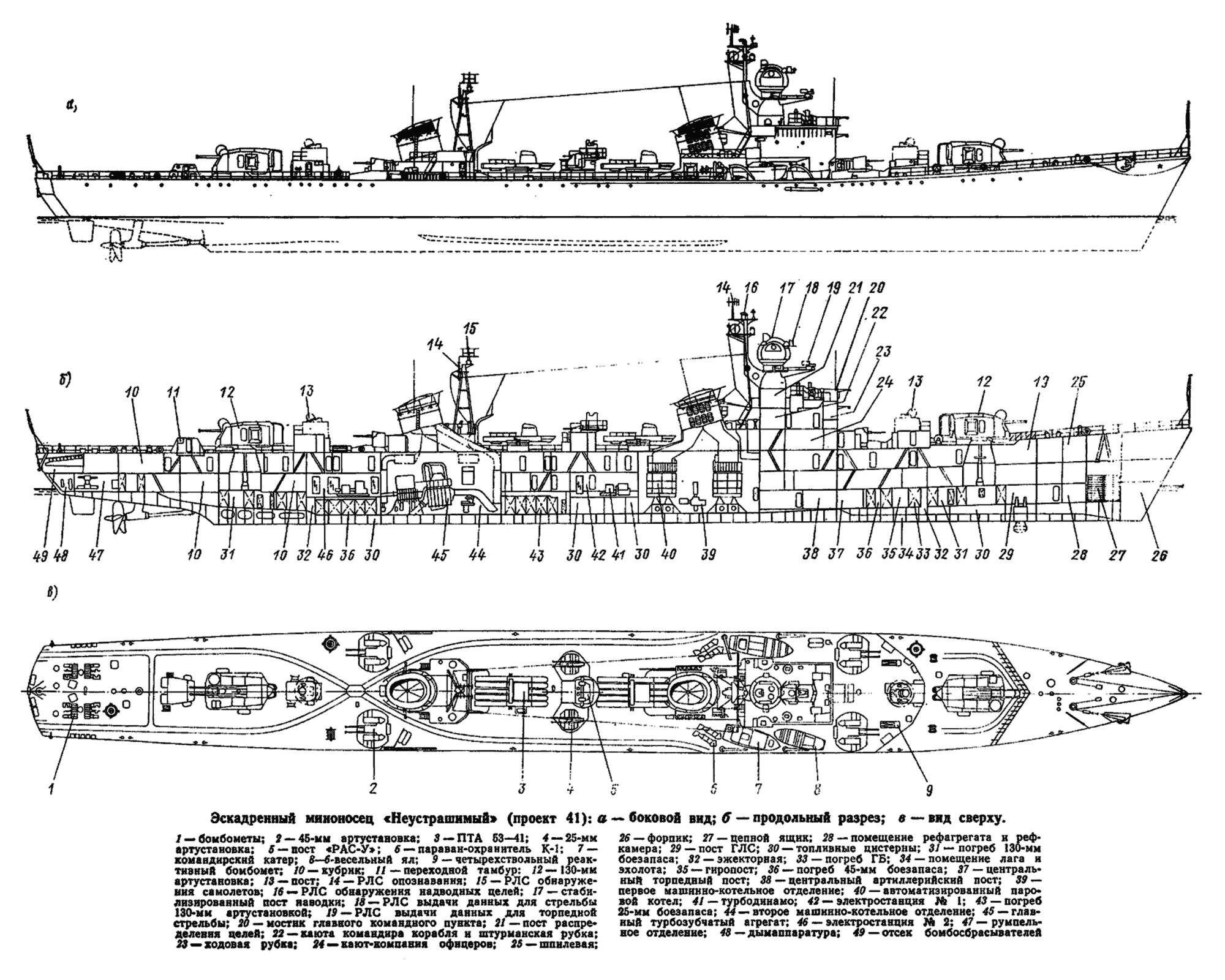
Original publication deeper look at the internals and other details
Powerplant
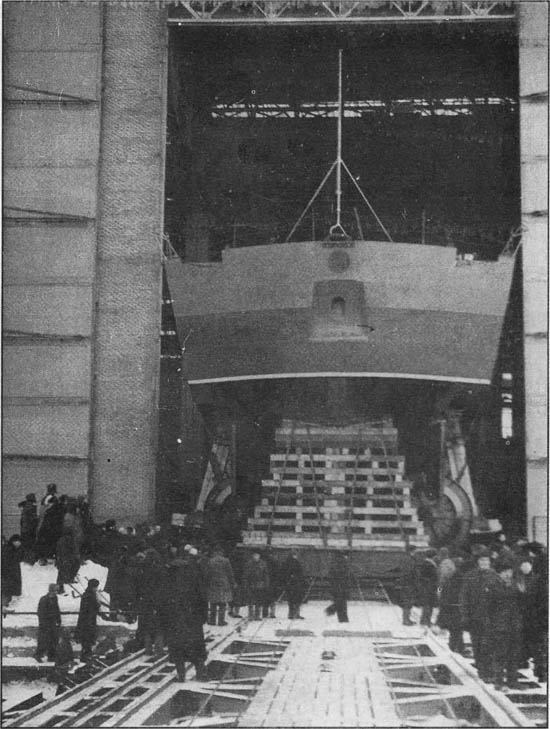
Stern view
The main power plant was also radically different from previous destroyers, with a two-shaft power plant housed in two independent and fully autonomous compartments in case of torpedo hit. If one was submerged, other compartments, forming an echelon could still assume propulsion of the ship. Each of these units housed a TV-8 type GTZA steam turbine which had by itself developed a total output of 33,000 hp on a small package. Two main boilers served them each. These Automated boilers of the 3-drum KV-41 “turbo” type used forced blowing directly into the furnace for a pressure pressure of up to 64 kg/cm 2. It was even launched without preliminary warming up. The ship with its two shafts still had better maneuverability than the Skoryy, with less propeller shaft revolutions. The whole powerplant was a feat of engineering by itself, beind reduced weight and dimensions, 100 tonnes lighter than the on the 30-bis project vessels. Fuel consumption turned out to be also 20% lower. Electrical power was also revolutionary: It called for the first time on a three-phase alternating current 220V at 50 Hz. The project 41 powerplant was the single greatest success of the design, copied on the Projects 56, 57bis, 58, 1134/1134A, 1123, and presumably also 1164 and 956.
Armament

Main armament:
It comprised two twin turret with 130-mm stabilized universal guns SM-2-1. Both were installed on deck level fore and aft. Each had its own enslaved Shtag-B radar rangefinder. They could be both operated through local and remote control, which was also brand new at the time. These 58 caliber guns received a common cradle so no independent barrel elevation however. This looked a step step backward compared to the Project 30 Skoryy turrets, but the reason for this was the total trust and hope into the new innovative stabilization system used, which precluded the turrets to have separate barrels due to dimensions issues. Such stabilization however turned out to be a fiasco and its development was discontinued. Firing data was generated by the Yakor-M radar, helped by a stabilized targeting gear SPN-500, assisted by a ZDMS-4 rangefinder. This data was processed via the Zenit-41 PUS system.
Anti-aircraft artillery:
It included four stabilized twin 45 mm SM-16 mounts, and two quadruple 25 mm 4M-120 mounts. The SM-16 were controlled either from the main local FCS, or from MZA telemeters, fed by data from the Foot-B radar. The 4M-120 guns were operated manually. They were provided with 4,000 and 10,000 rounds respectively total.
Torpedo armament:
It was represented by two quintuple 533-mm torpedo tubes, relatively classic and standardized. It was the same type as found on light cruisers of the project 68-bis (Sverdlov class). The torpedoes fired were likely of the PTA-53-41 Stalingrad T-41 coupled with the Zarya fire control system. This type which was later replaced by the model 53-51 (entering service in 1951), still a non-homing model but weighting, 4,134 lbs. (1,875 kg) for 299 in (7.6 m) in lenght, carrying a 661 lbs. (300 kg) warhead up to 4,400 yards at 51 knots or 8,750 yards (8,000 m) at 39 knots, using a Kerosene-air wet heater.
Mines & Depth charges:
In addition of mine rails mounted on the upper deck to carry up to 48 KB Krab naval mines or 48 GMZ models could be carried in all, conveyed to the mud chutes at the stern. In addition, Neustrashimy carried six BMB-2 DC projectors (48 in store) on the broadside, and two depht charge throwers, automated reload, with 57 in reserve. There was a General-purpose long range radio equipment and of course the the Foot-N air target detection radar, and Rif surface targeting system, plus the Pegasus Sonar.
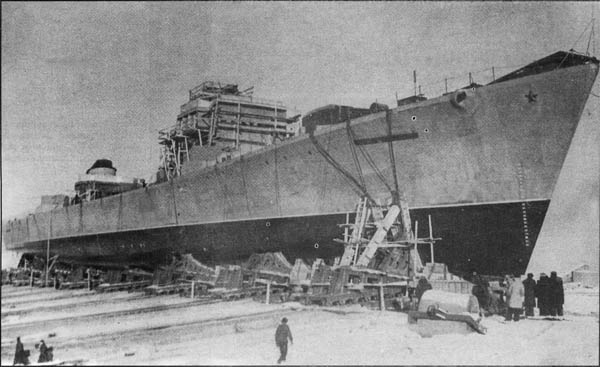
Launch
Noted design issues and fate
-Poor Agility: Despite all its promises, the innovative Neustrahimy was a difficult ship to complete and put into service due to the number of new systems invilvd and the general complexity which resulted of it. Neustrashimy was overll not a successful design. Soon trials revealed it was very slow to react to the helm, the rudders demultiplication gear seems to have been grossly underpowered, and the ships in fact turned better when using the two shafts. The rudders themselves were replaced by the ship still proved to be a “pig” when manoeuvering at full speed or even mid-speed. In addition also she vibrated badly aft.
-Poor speed: The biggest surprise came out also on trials, was the poor full speed reached and equally poor cruising range despite promising fuel efficiency: TTZ initially fixed the goal of reaching 36 knots, but only trials only 33.5 knots could be reached, weeping the boilers red hot.
The cruising range maintained at 14 knots was also supposed to be 5,500 miles, but it in the end, sea trials showed only 5,210 could be reached, by lowering speed and avoiding manoeuvers. In the trials acceptance report was noted the following: “… this happened due to the insufficient design capacity of the mechanical installation and errors in the methodology for calculating the propulsion by the Central Research Institute 45”. In this regard, “Fearless” was identified as an excessively large ship, too much for mass-production or reaching acceptable performances for destroyer standards, but still possessed significant reserves for modernization. However other problems were identified in the first live fire tests.
-Compromised AA fire: Another issue was the twin 45-mm AA guns. As they were placed in tandem, they could not be used simultaneously, and this was true for the forward and aft semi-batteries and broadside batteries that were unable to fire forward correctly and had overall limited arcs of fire. In addition, the SM-16 mounts themselves were non-serial and experienced lots of lingering teething problems. Also, the shape of the bow was noted to create way to much spray, again hampering the efficiency or even the all-weather use of the forward 130mm and 57mm AA guns;
-Radar issues: In addition, the untested Foot-B radar turned out to be unreliable.
This serie of initial mishaps conducted in June 1951 the Council of Ministers, to decide project 41 was going nowhere and the whole program was to be discontinued. Serial production was shelved, meaning all expensed made by preparing mass-production, procuring materials and sub-systems, and even all the hull down already were to be dismantled and recycled.

Sea trials in 1955
Career of the Neustrashimy
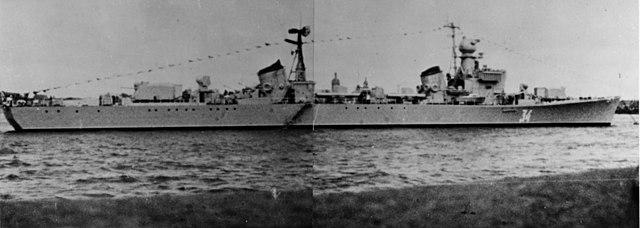
A short service time, of about 16 years
Neustrahimy was given the serial 614 and enlisted in January 31, 1955, but after long and gruelling trials of all kinds, she was only admitted into operational service on December 27, 1957 part of the 4th fleet from 26/07/1955. She was later transferred to the DKBF (Baltic Fleet). The whole detail: She made a trip around Denmark, and in summer, made another one to the Great Belt, Kattegat and Skagerrak and close to Scorland, past the Faroe Islands and Jan Mayen, then roamed the Norwegian Sea and the Orkney Islands. She returned to Barents Sea, and joined Severomorsk (Northern Fleet). She was back in the Baltic in late July 1955 and in August, sailed to the Shetland Islands, reached the 55th parallel. After a first refit followed in November 1960 ship’s composition was somewhat weakened and she was back in service in the spring of 1960. Her AA SM-16 mounted were replaced with the proven quad 45-mm SM-20-ZiF and the 25-mm mounts were removed altogether. The DC launchers were replaced with two RBU-2500 ASWRL, and the experimental “Foot B” replaced by an older, but proven and tested radar. In May she paradede at the Nevsky celebration, and after a stop in the baltic prepared for her first long oceanic cruiser, departing by August, and reaching the the Mediterranean Sea. She however never headed for the Black Sea, and came back to Portugal, the Channel, and back in September. In September under her Captain 3rd Rank B.V.Ivanov, Nikita Khrushchev decided to cross the Atlantic by sea, not on her board but the “Baltika”, and she became an escort.

Sea trials
She received a major modernization which took place from 21.5.1962 to 23.12.1963. It started on May 21, in “Tosmare” shipyard in Liepaja and she returned into service until October 1967, for her new overhaul. From 10.10.1967 to 6.1.1969 she underwent her second major overhaul, in Liepaja (Libau). This consisting of keeping the four quad 45mm/89 SM-20-ZIF of the first refit, plus two sextuple 16 RBU-2500 Uragan-2 ASWRL added, a Fut-N, and Yakor’-M2 systems, P-10 radars, Pegas-2M sonar and Machta-P4 ECM suite. But this only granted her six more years of active service.
On January 6, 1969, she was back into the channel and she became part of the 176th BEM in the Baltic. In October she saw her first and last “combat” damage while live firing she fired on a Project 56 (Kotlin) project “hastily”. One of her their 130-mm round hit the bottom of her freeboard aft superstructure, went through but did not made more damage nor crew casualty. In the summer of 1970 (Captain 2nd rank V.M.Demkin) she participated in the Polish People’s Republic Navy 25th anniversary, carrying Commander Admiral V.A.Kasatonova on board together with the battlecruiser Kirov (Captain V.P.Makarov). It was her last long trip abroad. After she participated in the Anniversary of the Revolution aval parade, she returned in Liepaja to take part in the new task force of the Baltic.

Baltic sea 1966
In autumn 1972 she was transferred in the 166 training Brigade in Kronstadt, alongside “Kirov”, “Zheleznyakov” and “Admiral Ushakov” and the training ships Borodino and Hanko; and “Bars” (project 50 ship) For the remaining 2 years of service, “Fearless” paraded in Leningrad on the Neva River in the autumn of 1973. On January 25, 1974 she was decommissioned but placed in reserve with preservation measures taken. She was eventually mothballed in Kronstadt. On 02/22/1974, she was fully disarmed, and sticken from the Navy list. She was put on the disposal list as a hulk 03/12/1974 and in in 1974-75 scrapped at the Glavvtorchermet base, Leningrad. This did not went out without a fight however: Sailors and workers at the Kronstadt Marine Plant, wanted to preserve her as a museum ship, due to the number of innovations she pioneered. Alas, they were ordered after a month to start dismantle her, including secret equipment. By mid-April this was done, and she was transferred to the Department of property stock. On board, however she was used by a floating Studio for the Ministry of Defence to create educational film on survival onboard such ship. The upper deck was put ablaze for it, successfully extinguished in accordance with the script, but her superstructure was completely ravaged. Towed to Leningrad she was beached at Turuhtannye Island, Coal Harbour, at the Leningrad Forestry port, waiting for the metal cutters to come.
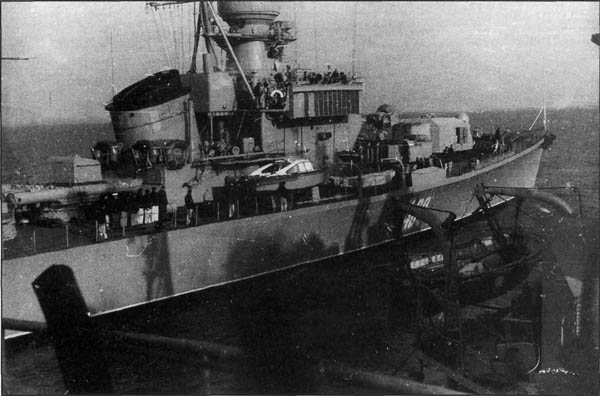
After her second refit in 1972
New revelations about Neustrashimy’s issues
Further sea trials later showed that the lack of speed of project 41 depended on deeper reasons. Indeed, the “Spokoiny”, lead ship of the project 56 program (Kotlin class) which was developed as an improvement of project 41, had both a lighter displacement by 400 tons and significantly more power at 10,000 shp but was still only able to reach one knot faster than Neustrahimy. This conducted to a thorough and exhaustive examination of both designs, by a specially created technical commission. The latter comprised all the best minds, mathematicians and experts in ship theory, headed by Professor Engineer-Rear Admiral V.G. Vlasov. They worked out the entire “stern-propeller-rudder” system developed for both designs and concluded it was designed incorrectly. The main problem was found in the grave distortion of the hydrodynamic flow created by the combination. It prevented the propellers to develop the necessary cavitation to reach these speeds, notably because of the generation of bubbles that sabotaged the water pressure around them. What was excellent for stealth was detrimental for high speeds. In the end, “Spokoiny”, the first Kotlin class destroyer, was to return in drydock for a rebuiding of the whole stern section, replaced by the corrected one suggested by the commission. It was not done on Neustrahimy though, which had a much shorter career.
Replacement by the Type 56 (Kotlin)
From the standpoint of today’s vision, the transition from Project 41 to Project 56 was unjustified. Most of its shortcomings could be eliminated by some time on drydock, as well as rapidly adjusting tooling and setup to launch the serie as initially planned, when considerable expenses had been done already. Project 41 still had a lot of valuable advanced technologies that could have been all been iron out, especially in comparison with the far less ambitious Project 56 in terms of greater survivability, autonomy, cruising range and a large size acting as a reserve for modernization. All these qualities were lacking in project 56 (Kotlin class) and it was felt especially acutely during the modernization phase, project 56-K “Bravy”. Indeed, engineers had to place solid ballast and use other tricks to meet requirements from the TTZ. Project 56, a far less satisfactory project replaced the Type 41 which never went into serial production, but it was not because of Stalin, which died in 1953 (decision was taken under Khrushchev). Old habits remained and mass production was decided against innovation. Only with the Kashin class USSR had the final word on this question, finding a valuable compromise.
Conclusion
There were many similarities between the Project 41 destroyer program and the T-64 Soviet main battle tank. Like the latter which replaced the very large postwar serie contemporary to the Skoryy-class destroyers, the legendary T-54/55, Project 41 was a revolutionary design, perhaps too ambitious for her age. She never reached full production but instead was replaced by a new serie, less ambitious in scope but more practical, the Kotlin class, and in tank equivalent, the T-72. With hindsight however, it’s clear that the Type 41 (Neustrahimy) would have been a kind of “elite” destroyer alongside the Kotlin, just as were the T-64 compared to the T-72s. The initial production of 110 ships was also very ambitious, but it could have led to numerous modifications and modernization and many exports along the way, well until 1990, so overall a cheaper proposition than the succession of short series that followed: 32 Kotlin, 8 Kildin, 14 Kashin, ann based on new plans and asking for extensive R&D. Nevertheless, Neustrashimy was indeed a “dauntless” proposal in 1950 that breakthrough many technologies and paved the way for these. Note: There are regular claims that plans were nevertheless sold to the Chinese and they became the base for the excellent Luda class, proving that the design was not “too large” or flawed.

Author’s old rendition
⚙ Specifications |
|
| Displacement | 3100 tons (standard), 3,830 tons (full load) |
| Dimensions | 133.83 m (439.1 ft) x 13.57 m (44.5 ft) x 4.42 m (14.5 ft) |
| Propulsion | 2× shaft geared steam turbines TV8 GTZA, 4 boilers, 66,000 hp |
| Propulsion (electric) | 2×400 kW TD-12 turbine generators, 1×100 kW turbine generator, 2×200 kW DG200/1 diesel generators |
| Speed | 36 knots (67 km/h; 41 mph) |
| Range | 20 days, 5210 nmi/14,1, 4300/17,7, 3080/23,8, 1000/33,5 kts |
| Armament | 2×2 130mm DP, 4×2 45mm, 2×4 25mm AA, 2×5 533mm TTs (2×5), 2 DCM, 6 DCT, 48 mines |
| Electronics | Radar Fut-N (air search), Ryf (surface), Sonar Pegas |
| Crew | 305 |
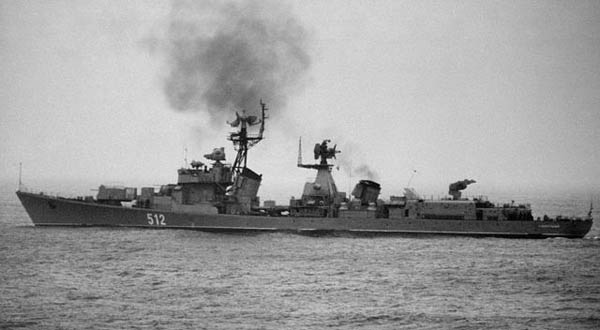
Soznatelnyy of the Kotlin class (Pr.56) which followed.
Read More/Src
atrinaflot.narod.ru
On Navypedia
Extra photos on navsource.narod.ru
Book on wunderwaffe about coldwar DD development
On russianships.info
navweaps.com 51-58 M1957 130mm
On globalsecurity.org
GG Book Stalin’s ocean going fleet
wiki
Gardiner, Robert (ed.) (1995). Conway’s All the World’s Fighting Ships 1947–1995.
Pavlov, A. S. (1997). Warships of the USSR and Russia 1945–1995.
Бережной С. Эсминец “Неустрашимый” (проект 41) «Морская коллекция» : Журнал. — 1995
Gallery
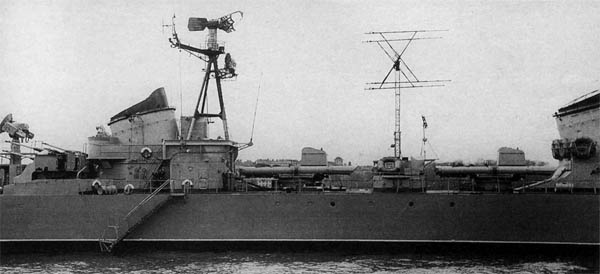
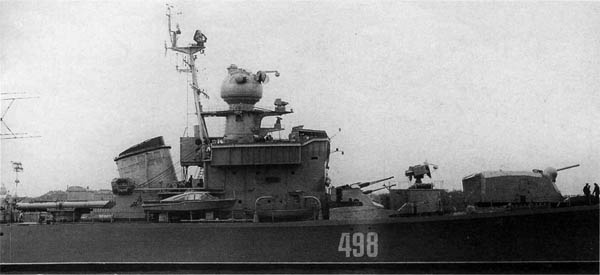
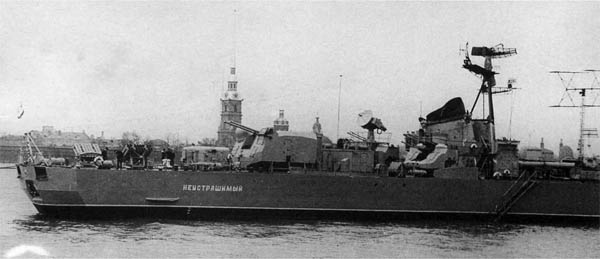
Various details (same source as all in this post but two marked “cc”: navsource.narod.ru
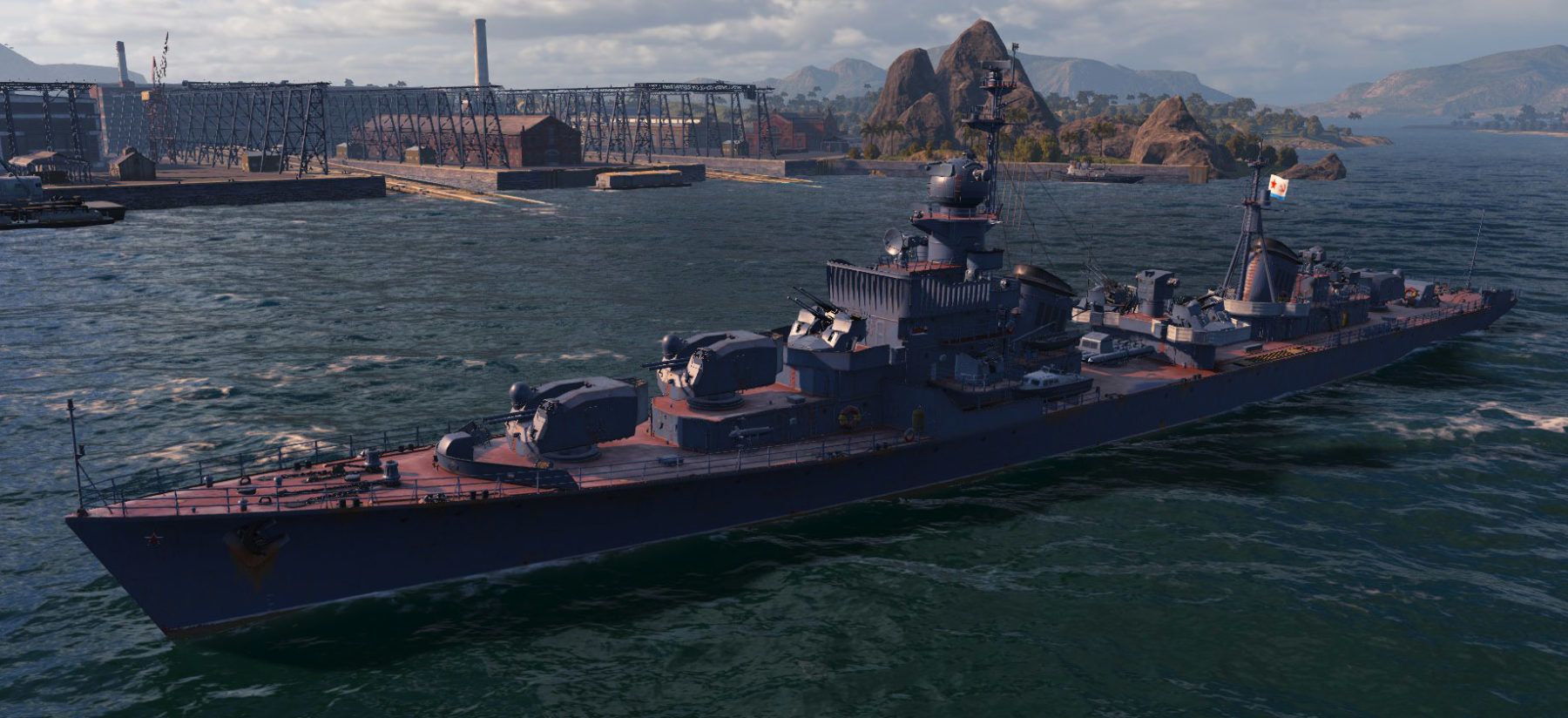
wow’s depiction of “Grozovoi” Pr.40N, an intermediate project close to Pr.41.



 Latest Facebook Entry -
Latest Facebook Entry -  X(Tweeter) Naval Encyclopedia's deck archive
X(Tweeter) Naval Encyclopedia's deck archive Instagram (@navalencyc)
Instagram (@navalencyc)





 French Navy
French Navy Royal Navy
Royal Navy Russian Navy
Russian Navy Armada Espanola
Armada Espanola Austrian Navy
Austrian Navy K.u.K. Kriegsmarine
K.u.K. Kriegsmarine Dansk Marine
Dansk Marine Nautiko Hellenon
Nautiko Hellenon Koninklije Marine 1870
Koninklije Marine 1870 Marinha do Brasil
Marinha do Brasil Osmanlı Donanması
Osmanlı Donanması Marina Do Peru
Marina Do Peru Marinha do Portugal
Marinha do Portugal Regia Marina 1870
Regia Marina 1870 Nihhon Kaigun 1870
Nihhon Kaigun 1870 Preußische Marine 1870
Preußische Marine 1870 Russkiy Flot 1870
Russkiy Flot 1870 Svenska marinen
Svenska marinen Søværnet
Søværnet Union Navy
Union Navy Confederate Navy
Confederate Navy Armada de Argentina
Armada de Argentina Imperial Chinese Navy
Imperial Chinese Navy Marinha do Portugal
Marinha do Portugal Mexico
Mexico Kaiserliche Marine
Kaiserliche Marine 1898 US Navy
1898 US Navy Sovietskiy Flot
Sovietskiy Flot Royal Canadian Navy
Royal Canadian Navy Royal Australian Navy
Royal Australian Navy RNZN Fleet
RNZN Fleet Chinese Navy 1937
Chinese Navy 1937 Kriegsmarine
Kriegsmarine Chilean Navy
Chilean Navy Danish Navy
Danish Navy Finnish Navy
Finnish Navy Hellenic Navy
Hellenic Navy Polish Navy
Polish Navy Romanian Navy
Romanian Navy Turkish Navy
Turkish Navy Royal Yugoslav Navy
Royal Yugoslav Navy Royal Thai Navy
Royal Thai Navy Minor Navies
Minor Navies Albania
Albania Austria
Austria Belgium
Belgium Columbia
Columbia Costa Rica
Costa Rica Cuba
Cuba Czechoslovakia
Czechoslovakia Dominican Republic
Dominican Republic Haiti
Haiti Hungary
Hungary Honduras
Honduras Estonia
Estonia Iceland
Iceland Eire
Eire Equador
Equador Iran
Iran Iraq
Iraq Latvia
Latvia Liberia
Liberia Lithuania
Lithuania Mandchukuo
Mandchukuo Morocco
Morocco Nicaragua
Nicaragua Persia
Persia San Salvador
San Salvador Sarawak
Sarawak Uruguay
Uruguay Venezuela
Venezuela Zanzibar
Zanzibar Warsaw Pact Navies
Warsaw Pact Navies Bulgaria
Bulgaria Hungary
Hungary

 Bundesmarine
Bundesmarine Dutch Navy
Dutch Navy Hellenic Navy
Hellenic Navy Marina Militare
Marina Militare Yugoslav Navy
Yugoslav Navy Chinese Navy
Chinese Navy Indian Navy
Indian Navy Indonesian Navy
Indonesian Navy JMSDF
JMSDF North Korean Navy
North Korean Navy Pakistani Navy
Pakistani Navy Philippines Navy
Philippines Navy ROKN
ROKN Rep. of Singapore Navy
Rep. of Singapore Navy Taiwanese Navy
Taiwanese Navy IDF Navy
IDF Navy Saudi Navy
Saudi Navy Royal New Zealand Navy
Royal New Zealand Navy Egyptian Navy
Egyptian Navy South African Navy
South African Navy






























 Ukrainian Navy
Ukrainian Navy dbodesign
dbodesign